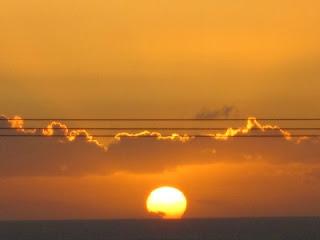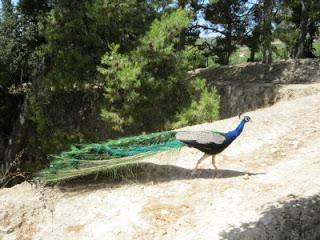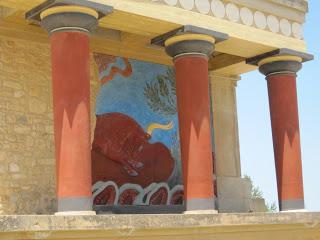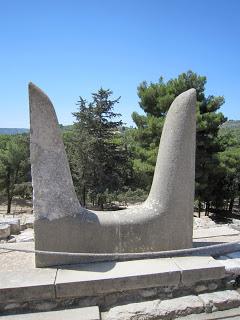Heidi is taking the week off, and so we have a guest today. H. S. Stavropoulos was born and raised in a small Greek Village in the middle of Oakland, California, and writes about being born in America to Greek immigrant parents and living between those two worlds. A frequent visitor to Greece and having hundreds of relatives there, H. S. Stavropoulos writes stories that describe life in Greece, Greek food (of course!!), the wealth of Greek culture, mythology and traditions, and the complex and wonderful Greek people.
The wonderful thing about visiting my family in Greece is that when I need to escape for a weekend getaway, I have hundreds of islands to select. I’d always wanted to see the Palace at Knossos, so Crete it was.
I flew in and grabbed a cab to my beachfront hotel. I spent the day swimming and as the day drew to a close and I walked along the shore listening to the gentle sound of waves lapping against the sandy beach, a single white flip-flop was tossed among the waves. I reached it and kicked it onto the beach, continued my walk, and eventually headed back to my hotel.

Sunset over Heraklion
I awoke to the sun shining into my room. I opened the window to admire the sea view. But today was not a beach day, today was for an archeological tour. I hopped on a local bus and headed into Heraklion, where I transferred to another, headed to Knossos. Arriving at Knossos, I walked the short distance to the gate, paid, and entered the heart of the Minoan Civilization.The day was hot and dusty and filled with the cries of peacocks. I’d never seen peacocks in the wild and for a time I was enthralled watching them, almost forgetting that they weren’t the reason I’d come.

Knossos peacock
I walked to the palace with its red columns and frescoes of dolphins, bulls, and bull-jumping youths. The colours were bold and vibrant and the artistry magnificent.I walked around the complex and was amazed that the site covered 20,000 square meters. The palace is a multi-storied structure with multiple floors, innumerable corridors and colonnades. I wondered as I peered down several levels with zig-zagging staircases that reminded me of an Escher painting whether this wasn’t the basis for the myth of the labyrinth.
The Palace of Knossos features in many myths about the Minotaur and the Labyrinth. In Greek, minotaur, means the “bull of Minos.” Minos was the King of Knossos. King Minos commissioned the great architect, Dedalos to build the labyrinth to house the Minotaur. But the King kept Dedalos prisoner to prevent him from revealing the layout. Dedalos fashioned two sets of wings from feathers and wax. He and his son, Ikaros, escaped by flying off the island of Crete. Ikaros flew too high and the sun melted the wax and he plummeted into the Aegean Sea.

Knossos Palace
Another myth surrounding the Palace is that of Theseus slaying the Minotaur. Crete required a tribute from Athens of young men and woman to be sacrificed to the Minotaur. Theseus, the son of the King of Athens, vowed to kill the Minotaur. If he succeeded, he would exchange the sails on his ship to white to alert his father, Aegeus. When Theseus returned, he forgot to change the sails, and his father jumped to his death from the Temple of Poseidon at Cape Sounion, thereby giving his name to the Aegean Sea.One modern theory is that the word “labyrinth” can be associated with the double headed axe, the labyrs, used throughout Crete.
As I walked about the palace, I thought of these rich stories filled with symbolism and tragedy.
I waited in line to view the alabaster throne, surrounded by reclining griffins painted on the walls of the room. I saw ceramic jars taller than myself. A double horned limestone sculpture, the symbol of the sacred bull, stood in an open area with tourists vying to be photographed in front of it.

Double horns at Knossos
After spending the better part of the day at Knossos, I returned to Heraklion, where I toured the open exhibits of the Heraklion Archeological Museum. The museum houses the actual frescoes from Knossos along with many of its findings. Items from other sites on Crete are also included. The Phaistos disc has always fascinated me with its hieroglyphic symbols arranged in a spiral that has never been translated.The next day I explored the city of Heraklion, once owned by ancient Venice. Along the stone walls built to fortify the city, I wandered past a large structure with vaulted ceilings and arches then walked to the old harbor. At the end of the pier I came to the Venetian fortress. I entered the cool and dark stone fortress and then walked up to the top of the battlements overlooking the sea.

Venetian fortress in Heraklion Harbour
I walked back towards the city and entered a pedestrian street filled with shops. I wandered through a pedestrian mall and cross streets until I reached a magnificent fountain in the center of the shopping district surrounded by cafes and restaurants.The Morozini Fountain is an ornate 17th-century Venetian fountain used to supply water to the fortified city. Water flows from the mouths of four lions into the base of the fountain.
After eating lunch, I went to the tomb of Nikos Kazantzakis, the writer known to most Americans for his story, Zorba the Greek. He is supposed to have lost the 1957 Nobel Prize for Literature by one vote to Albert Camus. Camus is reported to have said that Kazantzakis deserved it more.
Kazantzakis is buried outside the walls of the city of his birth, as he requested, since the church would not allow him to be buried in a cemetery. The epitaph on his grave reads, “I hope for nothing. I fear nothing. I am free.”
I ate at a seaside restaurant as the sun glowed orange as it set over the sea. That night, I mused over the sights I had seen on this too quick jaunt to Crete, knowing that there was much more to see and experience on the largest of Greece’s islands. The next day would see me on a plane returning to Athens.
Remember that white flip-flop I found on the beach? It inspired a story that will be published in Fish Nets, the second anthology of the Guppies Chapter of Sisters in Crime.

